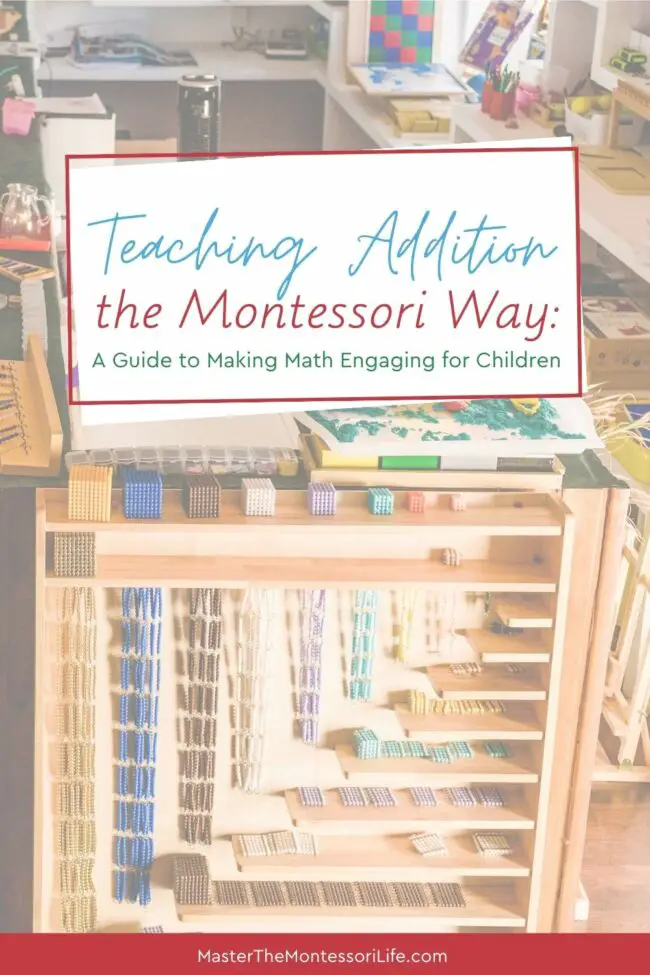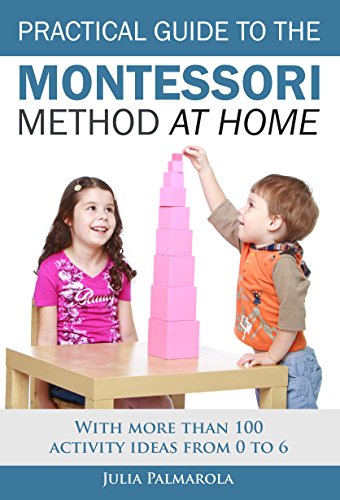Teaching math can seem daunting, especially when it comes to building a solid foundation for young learners. However, the Montessori Method, with its emphasis on hands-on learning and self-directed activity, offers a unique and effective approach to introducing addition to children.
I am so excited to be discussing this topic with you because it is one of my more frequently asked questions. This blog post will explore three key points that outline the Montessori method of teaching addition. It includes the essential Montessori math materials involved and the broader context of how addition fits into Montessori mathematics.

1. Teaching Addition Using the Montessori Method
Let me begin by telling you that I love teaching addition using the Montessori Method. It is so easy for Guides to teach and for children to grasp! Why? The Montessori Method shines in its ability to turn abstract concepts into tangible experiences for children.
When it comes to teaching addition, this approach emphasizes understanding over memorization, which is crucial for young minds grappling with mathematical concepts for the first time. Once they get it, it is a lifelong skill that they will easily remember and apply.
Concrete Before Abstract: Maria Montessori believed in the philosophy of introducing concrete tools before moving to abstract ideas. This means when teaching addition, children first get hands-on experiences with physical objects that they can count, combine, and manipulate.
It really is as easy as it sounds. This tactile process helps solidify the concept of ‘adding together’ in a child’s mind before they are introduced to numbers on a page.

Self-Correction and Independence: Another cornerstone of the Montessori approach is the encouragement of self-correction and independence. Montessori materials are designed in a way that allows children to see their mistakes and correct them on their own, fostering a sense of accomplishment and independence.
For addition, materials like the Bead Bars or the Addition Strip Board allow children to physically manipulate components to discover the sum of two numbers, noticing and correcting their errors independently. It is truly an awesome sight to sit back and simply observe.
Sequential and Cumulative Learning: Learning in the Montessori environment is both sequential and cumulative. This means each step in learning addition builds upon the previous one and prepares the child for the next.
This progression from simple to complex ensures a deep understanding of addition. It’s also laying a strong foundation for more advanced mathematical operations. So, don’t be afraid of repetition and a “back and forth” approach.
2. Essential Montessori Math Materials for Teaching Addition
Montessori materials are meticulously designed to aid in the learning process, making abstract concepts accessible through manipulation and exploration.
Bead Materials: One of the quintessential Montessori materials for teaching addition is the bead material. The Golden Bead Material, for instance, enables children to physically build numbers and see what happens when they are added together.
The Golden Bead Material is phenomenal because it offers a clear visual and tactile representation of the process of addition. Once you “see it,” you can’t “unsee it.” That is why it is one of my favorite Montessori materials to teach addition.
Addition Strip Board: Another indispensable tool is the Addition Strip Board. Believe me, it is well worth getting it! Children will enjoy using it over and over again. It allows children to practice addition facts in a hands-on manner.
Through the placement of strips on the board, children can visually see the results of different addition combinations, helping them internalize the concept. Get a printable version of it HERE.
Number Rods: The Number Rods introduce the concept of quantity and its association with numerals. By combining rods, children can see what happens when two quantities are brought together, laying the groundwork for addition. Get a printable version of them HERE.

3. Montessori Addition: A Holistic Approach to Mathematics
In the Montessori classroom, addition is not taught in isolation but as part of a holistic approach to mathematics. This approach ensures that children not only learn how to add. But it will help understand the why behind it, fostering a deeper appreciation and understanding of mathematics.
From Concrete to Abstract: The progression from concrete manipulation of materials to abstract mathematical thinking is central to the Montessori approach to addition. This gradual transition ensures children deeply understand mathematical concepts, learning not just how to calculate but to comprehend.
Integration with Life Skills: Montessori mathematics, including addition, is integrated with practical life skills. Children use their mathematical understanding in real-life contexts, such as setting the table or distributing materials. All of these reinforce their arithmetic skills and highlighting the relevance of mathematics in their everyday lives.
A Foundation for Future Learning: By embedding addition within a broader mathematical and practical context, the Montessori Method ensures that children are not only proficient in mathematical operations but also possess a comprehensive understanding of mathematics as an interconnected discipline. This foundation is crucial for their future learning and exploration of more complex mathematical concepts.
Enjoy Math the Montessori Way
Teaching addition using the Montessori Method offers a multifaceted approach. It combines tactile experience with conceptual understanding, independence, and practical application. By employing carefully designed materials and fostering an environment of sequential learning, children develop a thorough and meaningful understanding of addition, setting a strong foundation for their future mathematical endeavors.
You might also enjoy these relevant topics:
The Montessori Method The Secret of Childhood
The Secret of Childhood The Absorbent Mind
The Absorbent Mind The Discovery of the Child
The Discovery of the Child Montessori from the Start: The Child at Home, from Birth
Montessori from the Start: The Child at Home, from Birth Practical Guide to the Montessori Method at Home: With more
Practical Guide to the Montessori Method at Home: With more
- Introduce Hibernation, Migration and Adaptation to Children
 When you introduce your children to the concepts of hibernation, migration and adaptation, you will love to learn how they find food, which ones follow each of these survival techniques and so much more.
When you introduce your children to the concepts of hibernation, migration and adaptation, you will love to learn how they find food, which ones follow each of these survival techniques and so much more. - Montessori Farm Sensory Bin: Hands-On Learning
 A Montessori farm sensory bin is simple to assemble, rooted in purposeful work, and designed to invite deep exploration.
A Montessori farm sensory bin is simple to assemble, rooted in purposeful work, and designed to invite deep exploration. - Tips to incorporate Fall into your Montessori environment
 Come and find out how you can highlight and celebrate Fall in your Montessori environment without stressing out about it.
Come and find out how you can highlight and celebrate Fall in your Montessori environment without stressing out about it. - Hands-On Fun: 3 Montessori Practical Life Activities for Fall
 These simple Montessori Practical Life activities for Fall are easy to do anytime you have the materials ready.
These simple Montessori Practical Life activities for Fall are easy to do anytime you have the materials ready. - Embracing Autumn: A Montessori Guide to Fall Fun
 Spread the loveThe arrival of autumn brings a special kind of magic. The air turns crisp and leaves paint the…
Spread the loveThe arrival of autumn brings a special kind of magic. The air turns crisp and leaves paint the… - Montessori Toddler Essentials
 The Montessori method offers a pathway with a series of Montessori toddler essentials that you will find helpful.
The Montessori method offers a pathway with a series of Montessori toddler essentials that you will find helpful.






















Leave a Reply